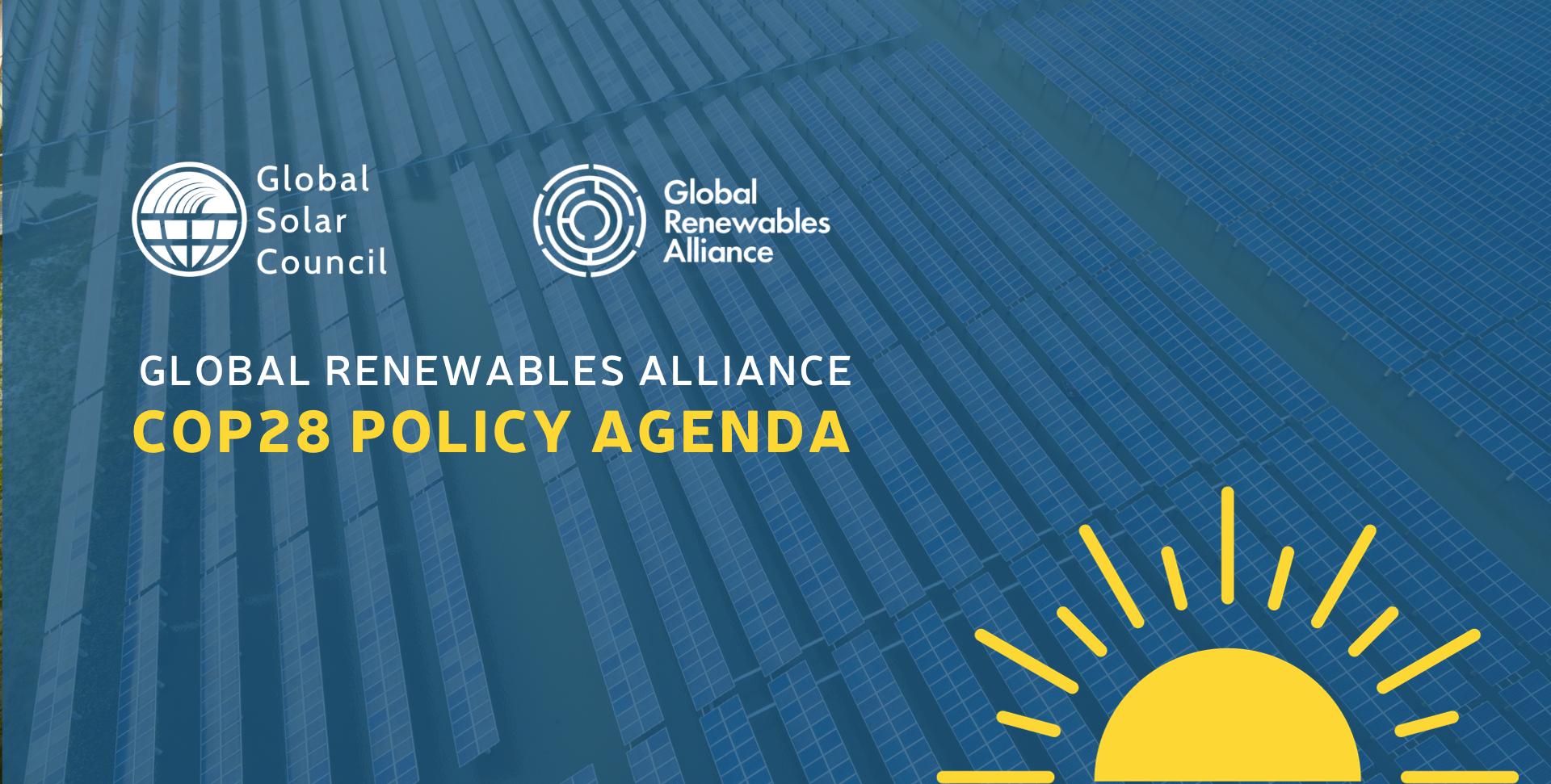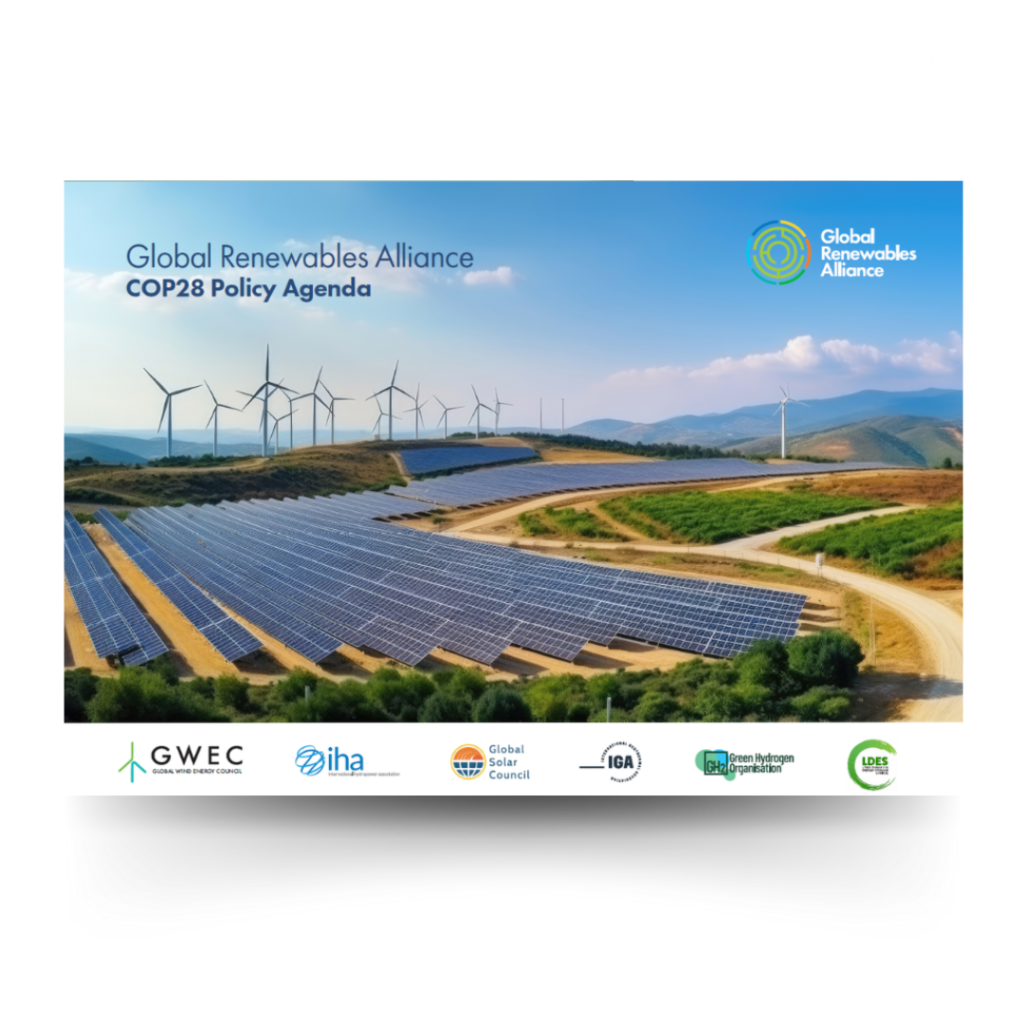
COP28 Policy Agenda
How to get to #3xRenewables by 2030
We are in the ‘make or break’ decade to avoid an irreversible fossil-fueled climate catastrophe. A global energy transition that dramatically accelerates the build-out of renewable energy in all regions of the world gives us the best chance of fighting climate change and building a clean, secure and just future.
Looking ahead at the actions needed for a 1.5C pathway, policymakers and heads of international energy agencies are convening around a shared goal to triple cumulative global renewable energy capacity to at least 11,000 GW by 2030. That means significantly accelerating annual installations of renewable energy sources like solar power, wind power, hydropower and geothermal power to reach annual installations of at least 1,500 GW by 2030. While this is a major step-change from today’s installation levels, it is possible with the right enablers in place.
In order to achieve this ambition and help the world avoid the worst impacts of climate change while contributing to sustainable development, the Global Renewables Alliance, of which the Global Solar Council is a founding member, has jointly published a COP28 Policy Agenda. This policy agenda is a call-to-action from the global renewables industry and aims to support policymakers and world leaders from across the world to install the renewable energy capacity needed to keep the world on a 1.5C pathway.


What does this mean for solar?
Solar PV can be deployed rapidly both at a large and small-scale, making it an ideal solution to keep pace with growth in power demand and ensure the sustainability of future economic growth. Solar PV also provides opportunities to be combined with energy storage or other renewable energy sources in hybrid power plants, which can ensure a reliable supply of clean and affordable electricity to customers. Finally, solar provides significant employment opportunities throughout its value chain, positioning it as the champion of the next generation of decent, secure jobs for workers. However, despite solar’s exponential growth in the last decade, its potential to be the foundation of a truly inclusive, just, and sustainable energy system of the future has yet to be realized. We encourage policymakers to address the barriers to global solar deployment as a matter of urgency to ensure a better future for people and our planet.
Explore below how each of the enablers in the Global Renewables Alliance COP28 Policy Agenda translates into solar-specific recommendations by clicking on each policy agenda point, or download the full document by clicking the button below.

AMBITION
Establish a global target to triple renewable energy capacity by 2030 to at least 11 TW.

What does this mean for solar?
Solar PV will sustain the increasing growth rates that it has experienced over the past decade. This continued growth will be driven by falling equipment prices, increased efficiency of modules, and its role as the lowest cost and most adaptable renewable energy technology. Leading market analysts project a compound annual growth rate of 21% between 2022-2030 in a business-as-usual scenario. According to SolarPower Europe’s medium growth scenario, over 6,2 TW of cumulative solar capacity could be installed globally by 2030. With the right policy, regulations and investments, cumulative global solar installations could reach as high as 7.9 TW by 2030 in a high scenario.
Based on these scenarios, annual solar installations by 2030 could be 1 TW in the medium scenario, and 1.5TW in the high scenario. This means that by the end of the decade, we would be installing the world’s current total solar capacity in just one year. These growth projections show that solar can contribute the lion’s share of the 11 TW target. The industry is ready to deliver this significant step-up in capacity, but realizing the high scenario will require clear, ambitious, and binding targets that match this potential, in addition to supporting financing mechanisms, policies and regulations. This will give the industry clear signals that the world is ready for solar and allow the sector to scale-up the supply chain accordingly to realize this significant uptick in demand.

DEVELOPMENT
Support massive deployment of both large and small-scale renewable energy, underlying infrastructure as well as flexibility solutions on supply and demand side and complementary technology.

What does this mean for solar?
Solar is unique compared to other energy technologies as it can be deployed in diverse use cases and by different types of stakeholders. From utility-scale solar parks to solar home systems in rural areas, solar undoubtedly has a large role to play in the energy transition in a wide array of countries and communities.
What sets it apart from other technologies is its ability to make both the largest and smallest generators – big power plants and homeowners – agents in the energy transition. Solar is the only generation technology that decentralizes electricity generation, giving people the power to produce and consume clean, cost-competitive energy. In developing countries, this means people don’t have to rely on a potentially unreliable and expensive supply of electricity from the grid. The decentralized potential of solar can also support the electrification of energy-intensive sectors like heating and transport, thus enabling higher penetration rates of renewable energy and reducing energy costs at the same time. Alongside capacity development planning on a national level, policymakers should encourage decentralized PV penetration to support local and regional economic development and ensure universal access to clean and affordable energy.
Historically, economic growth correlates with growth in power demand. As national economies, particularly those in emerging markets, continue to develop quickly, there is a risk that growth in generation capacity is not able to keep pace, leading to economic stagnation and wasted potential. Solar PV systems are comparatively quick to install and operationalize, making them an ideal technology to support growing power demand, economic growth and job creation around the world. To make the most of solar’s ability to be rapidly deployed, governments should look to build it into wider economic and electrification planning as a key enabler of socio-economic development.
In unstable political and economic regions, traditional power sources can be easily disrupted, while solar offers a reliable and sustainable solution and becomes essential in providing energy access to people in crisis. If utilized correctly, decentralized solar can provide an opportunity for economic recovery, sustain essential services throughout challenging circumstances, and increase resiliency against grid failure. It also has the potential to alleviate poverty and increase just distribution of development by providing access to affordable and reliable energy. Even in cases of natural disasters, whether they be climate-related or not, distributed solar PV can offer increased resilience to shocks – and is therefore also not just a form of climate mitigation but also adaptation. Solar can be deployed efficiently and quickly to generate electricity, enabling the operation of essential facilities and services like hospitals and emergency operations, and providing a much cleaner solution than the diesel generators currently in use for this.

GRID AND GREEN HYDROGEN INFRASTRUCTURE
Urgently invest in grid action plans which rapidly build out electricity grids, green hydrogen infrastructure, and heat systems for integration of large volumes of renewables and long-duration energy storage solutions.

What does this mean for solar?
Integrating substantial amounts of variable solar energy into electricity grids does not come without its challenges. The generation profile of solar PV systems does not necessarily perfectly fit the demand profile of off-takers, and in many cases solar-generated electricity from utility-scale projects must be carried through long-distance transmission lines with limited capacity to reach demand. This requires investment in new grid infrastructure, complementary technologies and flexibility mechanisms to ensure security of supply for consumers.
Developing an integrated strategy that coordinates grid upgrades with capacity addition schedules is key to avoiding curtailment of solar projects and creating market certainty for investors. Investing in grid-level energy storage or organizing auctions that contain a storage aspect should be considered. System operators should adopt decentralized smart grid models using solar PV, as it will reduce the need for high-voltage transmission lines by bringing generation closer to consumption. It will also allow the integration of many flexibility measures that can accommodate and manage new capacities of solar energy. In addition, interconnections with other countries can be a mutually beneficial way for one party to balance their grid, and the other to secure access to cost-competitive solar electricity, making regional integration of electricity systems and markets a viable way to increase solar penetration.

FINANCE
Multilateral and national finance flows should be aligned with investment needs for a 1.5°C-compliant pathway, and provide access to low cost capital in developing countries.

What does this mean for solar?
Access to low-cost and long-term financing is crucial for accelerating the energy transition and improving the economic viability and competitiveness of renewable energy. According to BloombergNEF’s New Energy Outlook, the world needs to spend a total of $8.3 trillion on renewable energy deployment between 2023 and 2030 to align with a global net-zero trajectory by 2050. As solar PV will be the backbone of the needed energy transition, climate finance must prioritize channeling financial instruments toward the scaling-up of the supply chain and the development and implementation of solar projects. In Addition, energy Infrastructure upgrades like electricity grid expansion and flexibility measures need urgent finance mobilization to allow the uptake of higher renewable energy shares and prevent curtailment.
Multilateral Development Banks and bilateral Development Finance Institutions are a key part of the solution in terms of financing solar and renewables projects in the Global South, and should be supported to scale up their project financing and de-risking instruments. Donor countries need to first make progress on making these institutions more financially efficient and then negotiate a round of major cash injections in return for root and branch climate-related reform. This will allow the World Bank and the other MDBs to lead the energy transition in every corner of the world, and in Least Developed Countries in particular where there are major resilience and adaptation benefits.

SUPPLY CHAIN
Commit to ambitious energy transition plans/milestones to allow the renewables and storage industry to effectively plan for efficient supply chain development.

What does this mean for solar?
A global target alone is not sufficient to maximize solar’s potential and reach 7.9 TW of cumulative installed capacity globally by 2030. To ensure that low-cost solar energy forms the backbone of the new energy system, governments should develop their own energy transition plans, in addition to strategies, action plans, impact assessments, and regulations, with clear solar-specific capacity deployment schedules, and provide financial incentives and support local financing institutions to service the solar industry.
These should be established as a priority to increase investor confidence, remove market barriers, and help supply chains scale up at the required rate to achieve targets. Significant efforts should also be made to create transparent solar supply chains that bolster national and regional industries, creating jobs and stimulating economic growth. Governments should promote the use of tools such as the Solar Stewardship Initiative to ensure high ESG standards are observed. Furthermore, significant efforts should be made to integrate separate national supply chains into a diversified international supply chain that is robust and can adequately support the growing demand for solar globally.

PERMITTING
Urgently streamline permitting schemes for grid-scale renewable energy projects, as well as long-duration energy storage projects.

What does this mean for solar?
A key problem faced by project developers internationally is acquiring land and requisite permits for installing solar power plants. Often, permitting procedures are administratively complex, take a long time, and contain a combination of national, regional, and sub-regional entities with overlapping responsibilities. Bottlenecks caused by permitting also have the potential to delay capacity addition schedules, creating greater uncertainty around investing in solar and discouraging end-users from transitioning to solar PV.
To avoid this, permitting procedures for solar projects should, follow a standardized, clearly defined, uncomplicated process and include maximum wait times after which permits are automatically granted. An ideal way of ensuring this is through the creation of one-stop shops for permitting renewables projects. The administrative burden of permitting procedures should also be proportionate to the size of the installation, ensuring that processes for rooftop solar and mini-grids are more streamlined than those for utility-scale considering that their impact on the grid, community, and environment will be relatively smaller.

DEMAND SIDE
Include simplified mechanisms for clean power procurement and pricing. Drive and facilitate demand for renewable electricity, green hydrogen and its derivatives by incentivizing industries to transition to clean energy sources.

What does this mean for solar?
Commercial and industrial consumers looking to source their electricity from solar energy should be able to achieve this without facing the limitations of project permits, land availability, and grid access. Energy regulators should introduce a variety of connection schemes and project types for both on-site and off-site solar projects to incentivize uptake. Consumers who don’t have land availability or favorable solar conditions on-site should have the right to utilize solar energy from another location, with support in the form of affordable grid-use rates and flexible procurement options. Similarly, businesses capable of installing on-site solar projects should be encouraged and enabled by upgrading the capacity and stability of the electrical grid, allowing different schemes that support self-consumption and energy storage, and allowing schemes that support off-grid solar energy production and use. In addition, solar corporate sourcing activities should be well-regulated to ensure fair and just access to solar energy for all consumers.

ENERGY STORAGE
Establish market mechanisms and remove barriers for energy storage.

What does this mean for solar?
Solar PV combined with storage is a game-changer for energy prosumers. These two technologies together provide a higher level of robust energy access, and can help consumers save money on their electricity bills by reducing their reliance on the grid, especially during peak hours when electricity prices can be high. Storage with distributed PV can also enhance grid stability, as grid operators can leverage these decentralized installations and offer incentives to consumers who participate in demand response programs or provide ancillary services to the grid when needed. Additionally, in energy-poor regions, or where there is no access to the electrical grid, storage complements solar PV to provide a constant flow of energy throughout the day to avoid electricity cuts, which significantly hampers economic growth.
Regulators and system operators should integrate storage-specific regulations and guidance into renewable energy systems connection schemes to enable efficient and affordable storage with solar PV solutions. Incentives should also be introduced to encourage project developers to combine storage with utility-scale solar PV, especially when solar electricity production could be subjected to curtailment. This would provide insurance to investors while offering flexibility and support to the grid.

INDUSTRY STANDARDS AND CERTIFICATION
Implement robust sustainability and technology standards/certification governing new projects and infrastructure.

What does this mean for solar?
Solar produces extremely cost-competitive electricity, and has one of the lowest Levelized Cost of Electricity (LCOE) of all generation technologies. But if tenders and auctions usually reward the projects offering the lowest prices for electricity, this can cause a race to the bottom in terms of prices. The risk with this is that projects are not bankable and cannot reach financial close, further delaying capacity addition schedules and negatively affecting investor confidence in the market. To avoid this, applying complementary assessment criteria, such as strong sustainability and technology standards, to projects awarded via auctions or tenders can help strike the right balance between price and bankability. Easing the need to offer the lowest price to have a chance of winning could help awarded projects to reach financial close more reliably, whilst still being able to offer cheap electricity.

ELECTRICITY MARKET DESIGN
Encourage regulatory and revenue stability and provide incentives for flexibility and dispatchability, and introduce simplified mechanisms for clean power procurement and pricing.

What does this mean for solar?
Considering that solar will contribute the majority of the renewable energy capacity needed to achieve net zero, building thriving national and regional solar markets is critical for the energy transition. To make this happen and meet national goals, countries will need to attract sustained investment for solar projects.
Given the commercial specificity of solar and the length of an asset’s lifetime, the most effective way to guarantee this is through a consistent policy framework, including support schemes, guarantees for project developers that will help them sell the most electricity possible, and long-term ambitions and key transition milestones. Policy gaps should also be quickly remedied to provide stability for investors and any changes to regulatory frameworks should avoid imposing extra conditions retroactively on solar projects, as this will spoil investor appetite and stall market growth. Similarly, whilst support schemes such as feed-in tariffs, net metering, or green certificates can help to boost solar deployment in the short term, they must be developed as part of a larger strategy that includes longer-term policies that can develop a robust and sustainable market such as tendering or auctions. This way, lessons learned can be integrated effectively and policy vacuums can be avoided.

CARBON MARKETS
Progress the implementation of the global rulebook on carbon markets.

What does this mean for solar?
A comprehensive carbon taxing framework must integrate solar energy initiatives and other renewable technologies, to encourage sustainable energy use while decentivizing carbon-intensive energy sources such as coal. The flexibility and cost-effectiveness of solar energy can fill in the gaps and complement carbon taxes and limits, thus ensuring continued low-carbon economic growth.
Yet, many carbon-intensive industries and value chains will be disrupted if the right market conditions and regulations are not in place. Therefore, governments must provide a clear framework and incentives for both on-site and off-site solar installations aimed at covering energy consumption and reducing emissions. For example, linking carbon taxing directly to solar projects by offering incentives in the form of tax credits or subsidies, could make solar installations more financially attractive to carbon emitters. In addition, the introduction of national and regional carbon markets and programs to buy and trade credits generated by emission reduction projects, could encourage businesses and industries to invest in solar installations as carbon reduction initiatives.

JUST AND EQUITABLE ENERGY TRANSITION
Ensure the energy transition leaves no one behind.

What does this mean for solar?
With an increased deployment of distributed solar PV, individuals and communities will have greater control over their energy sources and consumption. It allows them to become energy prosumers reducing their reliance on centralized fossil fuel-based systems and offering a degree of energy independence. Also, communities can establish solar cooperatives that ensure fair access to affordable, clean energy for all residents. Thus, solar PV enables shifting the patterns of participation and ownership within the energy transition by directly involving communities and individuals in the energy decision-making process and implementation, ensuring a just energy transition process, and helping to realize energy democratization.
A just energy transition should be inclusive, which is why it is essential to implement awareness-raising initiatives like the ‘Empowering people with solar PV‘ campaign, to engage people and educate them about the benefits of distributed solar and how they can be part of the energy transition. Additionally, all barriers preventing individuals, communities, and other consumers from installing solar PV must be lifted, and replaced with incentives and programs to ensure the equitable distribution of benefits for all.
Furthermore, multilateral partnerships between countries in the global North and global South should be prioritized as a way of mobilizing funding and technology transfer for just energy transitions globally. These partnerships should include participation at the highest political levels to ensure strong strategic direction and target-setting. Furthermore, they should integrate the voice of the private sector and solar industry associations, securing a good balance of in-country expertise and international good practices. This way, the major roadblocks to investment in solar in partner countries can be addressed head-on and collaboratively dismantled.

NATURE POSITIVE
Maximize the potential for an environmentally friendly transition with net-positive biodiversity impacts.

What does this mean for solar?
The solar industry is continuing to develop innovative ways that available land can be used for solar PV installations that reduce impact on nature. This decreases competition for greenfield sites with other renewable technologies, and ensures that existing spaces and surfaces are used to maximum efficiency. Sustainable agricultural practices utilize this in what is known as agri-PV, reaping dual benefits by having clean energy in addition to controlling the amount of light falling on the crops or grass beneath the installation and maximizing their annual yield. Floating PV opens opportunities to reuse brownfield sites, such as quarries, and reservoirs behind hydroelectric dam schemes. Finally, rooftop and BIPV can help urban areas play a significant role in the energy transition, maximizing available surface area. New applications such as agri-PV, floating PV, rooftop, and BIPV should be fully exploited by national governments to fully unleash the solar potential in their countries.
In recent years, increasing numbers of studies have emerged that show solar’s potential to support biodiversity. A solar farm located on degraded land, for example, can help to finance its restoration and provide shelter to plants growing under the solar panels, improving soil carbon stocks, and enhancing the nitrogen cycle by promoting animal grazing. Similarly, it has been found that PV projects located on agricultural lands can considerably improve local flora and fauna. National governments should look to PV not only as a clean, low-cost electricity generation technology, but also as a tool to support their biodiversity objectives.
Although Solar PV can contribute to countries’ environmental protection goals throughout the lifetime of the installations. Yet once, revamped, repowered or decommissioned , it is critical to properly manage the retired solar panels and other materials. To mitigate any environmental risks, regulators and the solar industry must work together to put in place Extended Producer Responsibility (EPR) regulations, which should apply to all renewable energy products and sources. Implementing EPR rules and procedures for the proper disposal, reuse, and recycling of end-of-life solar system components, such as photovoltaic panels, inverters, and Battery Energy Storage Systems (BESS) can help guarantee an environmentally sound level of waste management in regions and countries. Establishing designated processing facilities is a key part of the solution, and ideally it would feed the output material into local supply chains to service new raw materials, products and renewable energy equipment. Over 90% of solar panel components can be recycled, making solar PV a key part of the circular economy.
